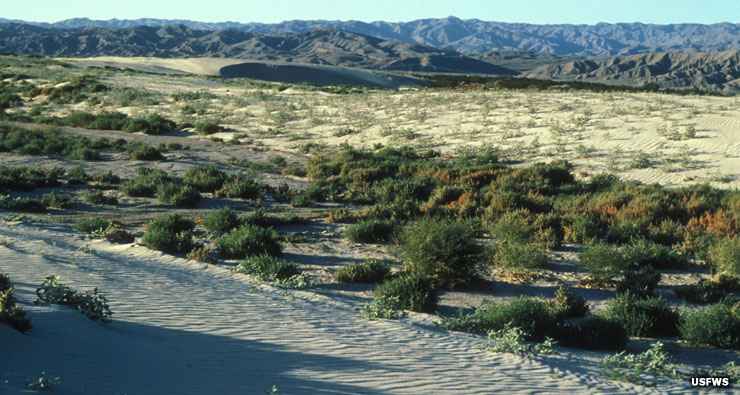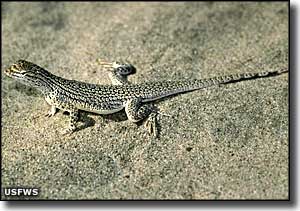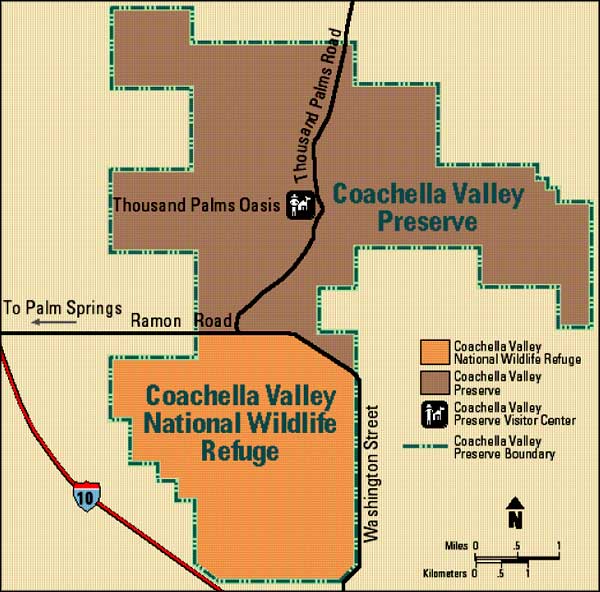Coachella Valley National Wildlife Refuge

Coachella Valley National Wildlife Refuge

Coachella Valley fringe-toed-lizard
The 3,709-acre Coachella Valley National Wildlife Refuge contains nearly all the remaining sand dune habitat critical to the survival of the Coachella Valley fringe-toed lizard (Uma inornata) within the Coachella Valley Preserve. The lizard is a listed threatened species that lives in the refuge dune system and a few nearby smaller areas. Also found on the property is the endangered Coachella Valley milk vetch, Coachella Valley giant sand treader cricket, Coachella Valley Jerusalem cricket and the Coachella Valley round-tailed ground squirrel. Coachella Valley National Wildlife Refuge is virtually closed to the public in order to fully protect the remaining few fringe-toed lizards and their habitat. There is one 24-foot wide corridor for hiking and horseback riding along the west refuge boundary and through the northern portion of the refuge that is still open to the public.
The major work being done at Coachella Valley NWR is habitat restoration. There are several stands of imported salt cedar being removed from the property in order to facilitate better sand movement. One hundred years of residential, agricultural and industrial development in the Coachella Valley has been threatening local sand sources and wreaking havoc with the fringe-toed lizard's habitual travel corridors. For thousands of years the Cahuilla Indians were the only inhabitants of the valley. Now, more than 100,000 people live here permanently and more than 1 million visit the area every year.
This dynamic sand dune habitat is also home to one of the most ecologically diverse desert communities in North America. Many of the other species of plants and animals are also extremely rare and found only in this neighborhood on the planet. Climate change, evolution and human encroachment have made them all extremely dependent on this last vestige of what was once a far larger sand dune ecosystem. At one time, this northern extension of the Colorado Desert offered about 270 square miles of loose, wind-blown sand to these creatures. At this point in time, that habitat has been reduced to less than 50 square miles of blowsand habitat in fragmented patches scattered through the valley from Indio to San Gorgonio Pass.
Surveys of the habitat and counts of surviving lizards are conducted every year in the spring and early fall.
The Coachella Valley Preserve is a joint project managed cooperatively by the US Fish & Wildlife Service, Bureau of Land Management, The Nature Conservancy, California Department of Parks and Recreation, California Department of Fish & Wildlife and the Center for Natural Lands Management.
Coachella Valley National Wildlife Refuge is administered as part of the Sonny Bono Salton Sea National Wildlife Refuge Complex. The Nature Conservancy operates a visitor center (manned by volunteers) at the Thousand Palms Oasis. There is a 1-mile hiking trail from there that leads across the San Andreas fault line and through a wash to end at the McCallum Palm Grove. In the visitor center you'll find brochures with information about longer hikes and equestrian trails in the area. Coachella Valley Preserve is open from sunrise to sunset daily except for July and August. Because there are five different agencies involved in the management of the property, public use rules can vary radically from one area to another.

Upper left photo courtesy of William Radke, US Fish & Wildlife Service
Other photos and map courtesy of the US Fish & Wildlife Service